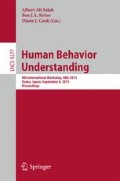Abstract
Caregivers of people with cognitive impairment need assistive technologies capable of reducing stress of constant monitoring of patient. In this paper we discuss information technologies employed for sensing and identification of basic behavioral activities of a patient in a low-cost caregiver assisting system. By analyzing readings from heterogeneous sensors, the system automatically detects the activities, assesses risks which they may have for the patient’s health, evaluates emergency of assistance and alerts the caregiver in a case of emergency. We present algorithms for activity identification, emergency computation and show results of empirical evaluation in a prototype in-home caregiver assisting system. As experiments revealed, the system has identification rate for basic activities higher than 94 %.
Access this chapter
Tax calculation will be finalised at checkout
Purchases are for personal use only
References
Number of dementia patients to reach around 7 million in Japan in 2025, The Japan Times, 8 January 2015, Accessed on www.japantimes.co.jp/news/2015/01/08/national/number-dementia-patients-reach-around-7-million-japan-2025/
Hara, K.: Dementia Policy in Japan, Accessed on www.igakuken.or.jp/english/e_research/…/list00.pd (in Japanese)
Pollak, C.P., Perlick, D., Alexopoulos, G., Gonzales, A.: Disruptive nighttime behaviors in elder caregiver pairs. Sleep Res. 23, 305 (1994)
Raintz, M.J., Skubic, F.M., Alexander, G., Aud, M.A., et al.: Improving nurse care coordination with technology. Comput. Inform. Nurs. 28(6), 325–332 (2010)
Yasuda, K., Kuwahara, N., Morimoto, K.: Remote reminiscence talking and scheduling prompter for individuals with dementia using video phone. In: Stephanidis, C. (ed.) Universal Access in HCI, Part I, HCII 2009. LNCS, vol. 5614, pp. 429–438. Springer, Heidelberg (2009)
Technologies to Help Older Adults Maintain Independence: Advancing Technology Adoption, Center for Technology and Aging, July 2009. Accessed on www.techandaging.org
Davenport, T.H.: Thinking for a Living: How to Get Better Performances and Results from Knowledge Workers. Harvard Business School Press, Boston (2005)
Mihailidis, A., Barbenel, J.C., Fernie, G.R.: The efficacy of an intelligent othosis to facilitate handwashing by persons with moderate to severe dementia. Neuropsychol. Rehabil. 14, 135–171 (2004)
Nakagawa, K., Sugihara, T., Koshiba, H., Takatsuka, R., Kato, N., Kunifuji, S.: Development of a mimamori-care system for persons with dementia based on the real world-oriented approach. In: Apolloni, B., Howlett, R.J., Jain, L. (eds.) KES 2007, Part II. LNCS (LNAI), vol. 4693, pp. 1261–1268. Springer, Heidelberg (2007)
Miskelly, F.: A novel system of electronic tagging in patients with dementia and wandering. Age Ageing 33, 304–306 (2004)
Informedia Caremedia: Automated video and sensor analysis for geriatric care. Accessed on www.informedia.cs.cmu.edu/caremedia/
Bharucha, A.J., Anand, V., Forizzi, J., Dew, M.A., Reynolds, C.F., Stevens, S., Wactlar, H.: Intelligent assistive technology applications to dementia care; Current capabilities, limitations and future challenges. Am. J. Geriatric Psychiatry 17(2), 88–104 (2009)
Just Checking, Helping people to stay at home. Accessed on http://www.justchecking.com.au/
Williams, K., Arhur, A., Niedens, M., et al.: In-home monitoring support for dementia caregivers: a feasibility study. Clin. Nurs. Res. 22(2), 139–150 (2013)
Intille, S., Larson, K., Tapia, E.M., et al: Using a live-in laboratory for ubiquitous computing research, in Proc. Pervasive06, pp. 359–365 (2006)
Klingbeil, L., Wark, T.: A wireless sensor network for real time indoor localization and motion monitoring. In: Proceedings of the 7th International Conference on Information Processing in Sensor Networks, pp. 39–50 (2008)
D’Souza, M., Ros, M., Karunanithi, M.: An indoor localisation and motion monitoring system to determine behavioural activity in dementia afflicted patients in aged care. Electron. J. Health Inform. 7(2), 1–8 (2012)
Rowe, M., Lane, S., Phipps, C.: CareWatch: a home monitoring system for use in homes of persons with cognitive impairment. Top. Geriatr. Rehabil. 23, 3–8 (2007)
Moshnyaga, V.G., Tanaka, O., Ryu, T., Hashimoto, K.: An intelligent system for assisting family caregivers of dementia people, IEEE Symposium on Computational Intelligence in Healthcare and e-Health (2014)
FSR 406 Data Sheet, FSR 400 Square Force Sensing Resistor, Interlink Electronics. Accessed on www.interlinkelectronics.com
Tanaka, O., Ryu, T., Hayashida, A., Moshnyaga, V.G., Hashimoto, K.: A smart carpet design for monitoring people with dementia. In: Selvaraj, H., Zydek, D., Chmaj, G. (eds.) Progress in Systems Engineering. Advances in Intelligent Systems and Computing, pp. 653–659. Springer, Switzerland (2014)
Miura, M., Ito, S., Takatsuka, R., Sugihara, T., Kunifuji, S.: An empirical study of an RFID mat sensor system in a group home. J. Netw. 4(2), 133–139 (2009)
Author information
Authors and Affiliations
Corresponding author
Editor information
Editors and Affiliations
Rights and permissions
Copyright information
© 2015 Springer International Publishing Switzerland
About this paper
Cite this paper
Moshnyaga, V., Osamu, T., Ryu, T., Hashimoto, K. (2015). Identification of Basic Behavioral Activities by Heterogeneous Sensors of In-Home Monitoring System. In: Salah, A., Kröse, B., Cook, D. (eds) Human Behavior Understanding. Lecture Notes in Computer Science(), vol 9277. Springer, Cham. https://doi.org/10.1007/978-3-319-24195-1_12
Download citation
DOI: https://doi.org/10.1007/978-3-319-24195-1_12
Published:
Publisher Name: Springer, Cham
Print ISBN: 978-3-319-24194-4
Online ISBN: 978-3-319-24195-1
eBook Packages: Computer ScienceComputer Science (R0)

